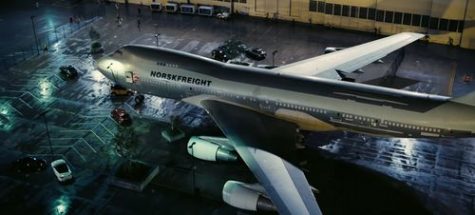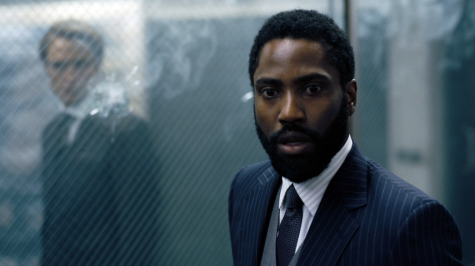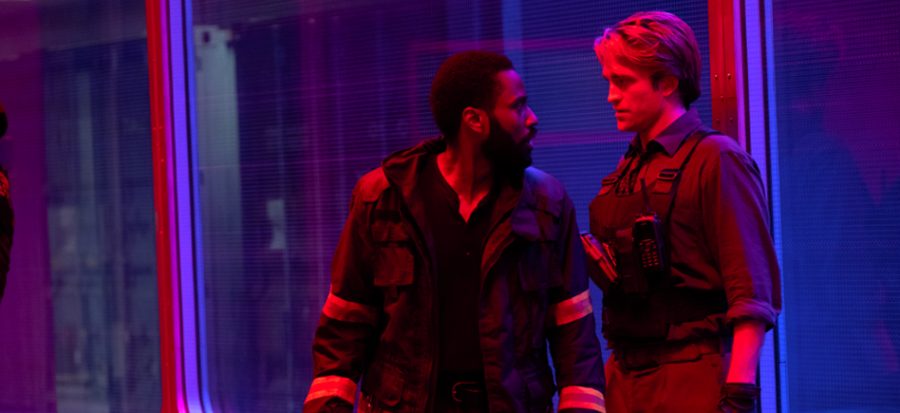Tenet Movie Review
“Tenet”: A Thrilling Visual Spectacle
(Photo courtesy of Warner. Bros)
The Protagonist (John Dacid Washington) and Neil (Robert Pattinson) contemplate on what their next move will be. “Tenet” exhibits phenomenal visual aspects throughout the entirety of the film.
Oct 15, 2020
“Inversion – the ability to reverse an object’s entropy.” – The Protagonist
“Tenet” is Christopher Nolan’s most ambitious film to date. His well known and extensive career that kicked off with films such as “Memento”, “Batman Begins”, and “Inception” has now led to one of his most highly anticipated films, “Tenet”, which far exceeds the number of risks and creative choices within the script compared to any other film in Nolan’s filmography portfolio.
The ideas and pieces of “Tenet” have been in the director’s head for years, evident in his previous movies where concepts such as inverted bullets appear in as early as one of his first films, “Memento”, released in the year of 2000. Now, in select theaters across the country and even more across the globe, Nolan welcomes audiences back into theaters to see what the marketing campaign of the film describes as an “Immersive Experience.” Does the film live up to the amount of excitement that it has racked up in the past six months or does it fall flat?

SOUNDTRACK
One of the major differences in this film compared to the other Nolan films is the composer. Nolan’s normal go-to composer is Hans Zimmer, whom he worked with on “The Dark Knight Trilogy”, “Inception”, and “Dunkirk”. Zimmer has been busy composing a new film named “Dune”, so he was unable to work on this project. Nolan decided to collaborate with the rising to fame composer Ludwig Goransson, who just recently won an Emmy for his work on “The Mandalorian” and received praise for his work on “Black Panther”.
Goranssons score syncs perfectly with what’s going on in the scene. “Tenet” starts with a bang—quite literally. It opens to an orchestra performing, with the soundtrack reflecting the opening notes rising slowly, until abruptly stopping when they are raided by a militia (as seen in the trailer). The score reflects the raid with bombastic, repetitive drums as the camera pans out to the outside of the opera house, and the score ramps up with more percussion instruments—a great way to start off the film.
Another unique aspect of this film is how it deals with time travel, or as they describe it: “inversion”. Goransson was challenged to also have his music reflect that, meaning he had to compose a score that sometimes sounded or was performed backward to how it would traditionally sound or be performed as. Overall, Goransson proves himself to be highly versatile through his several projects in the past five years, and seeing him collaborate with Nolan again would not be a surprise.

ACTING
This time around, Nolan’s crew surprisingly consists of an almost all-new cast for him to direct, as it’s normally filled with his very close friends and sometimes even family, such as his wife. She has been the producer for all of his films, and he also consistently works with Warner Bros. to distribute his films as well as working with the same cinematographer for his past several films, Hoyte Van Hoytema.
Seeing Nolan with such a young and new cast was an intriguing and delightful thing to experience. For protagonist John David Washington, this is his first big-budget feature-length film, and although he was asked to do more stunts than with his character emotionally, he delivered. Almost every stunt with David’s character in the film was learned and performed by him after months of training, planning, and rehearsing, which for a normal actor is usually too much to worry about. David’s performance, although a bit cold and not very emotion-filled, was the perfect way to deal with a spy—keeping their backstory unknown and having their mission be the number one priority.
As for the other protagonist character in the movie, played by Robert Pattinson (Neil), he was one of the more intriguing characters, not just due to the implications on the character, but also because this is Pattinson’s first big-budget film in a while since he went on what felt like a Hollywood-film-strike for the past several years after his most well-known project, “The Twilight Saga”, appeared in small but critically successful indie movies such as “Good Time”, “The Lighthouse” and “The King”. Pattinson’s character played well, yet the curiosity and ambiguity surrounding the character especially toward the third act of the film were far more intriguing.

Visuals
Nolan’s past films have all been applauded for the impressive amount of practical and stunt work throughout the films—something not many films or filmmakers in the action genre seem to care much about. In Tenet, he once again continues sticking with practical effects, stating in an ICG Magazine interview, “[Tenet’s] VFX count is probably lower than most romantic-comedies.”
The visual side of Tenet is huge and an integral part of the story. For example, in a scene in the second act of the film, the characters have to crash a Boeing 747 as a distraction, which ultimately helps them in the current time and in the future. Both scenes, normal and inverted, deliver spectacular and memorable cinematography as well as music that makes you feel as though you’re running along with the characters.
Another scene takes place during the third act of the film that features a war between inverted and un-inverted soldiers displaying some trippy and mind-boggling shots of buildings and ammunition being seen through each sides’ perspective, meaning everything occurred backward or “inverted” to each team. It was remarkable to see on screen with practical effects.
For the film featuring less than 300 shots of VFX, which is low in comparison to other Action Blockbuster films such as “Avengers: Endgame”, which contained around 2,500 shots of VFX. The low amount of it in “Tenet” is thanks to Nolan’s love for practical filmmaking as well as the cast’s commitment to doing stunt work and inverted actions and lines themselves, making the visuals even more phenomenal.
Tenet ultimately offers a bombastic, memorable and delightfully intriguing experience that will not let down the theater-deprived moviegoers. The effects in the film alone will leave the audience astonished and wanting more, yet, sadly with the film’s low domestic performance numbers, it’s something viewers may never get. Tenet will not only go down as one of the first films to bring back and save theaters, but it will also go down as one of the most ambitious and original films of all time. For tickets, times, and available ticket locations near you to see the film, visit TenetFilm.com.







stzgists ◊ Jan 14, 2021 at 6:13 am
This tenet movie was so confusing the first time I watched it that I had to delete it even my family members were all pissed, but when my friends were talking about it I had to go get it again and watched and understand it. however I later watched another movie lupin and that one I really like and I think that’s the best tv series this year, check my post to see how to Stream or Download it.